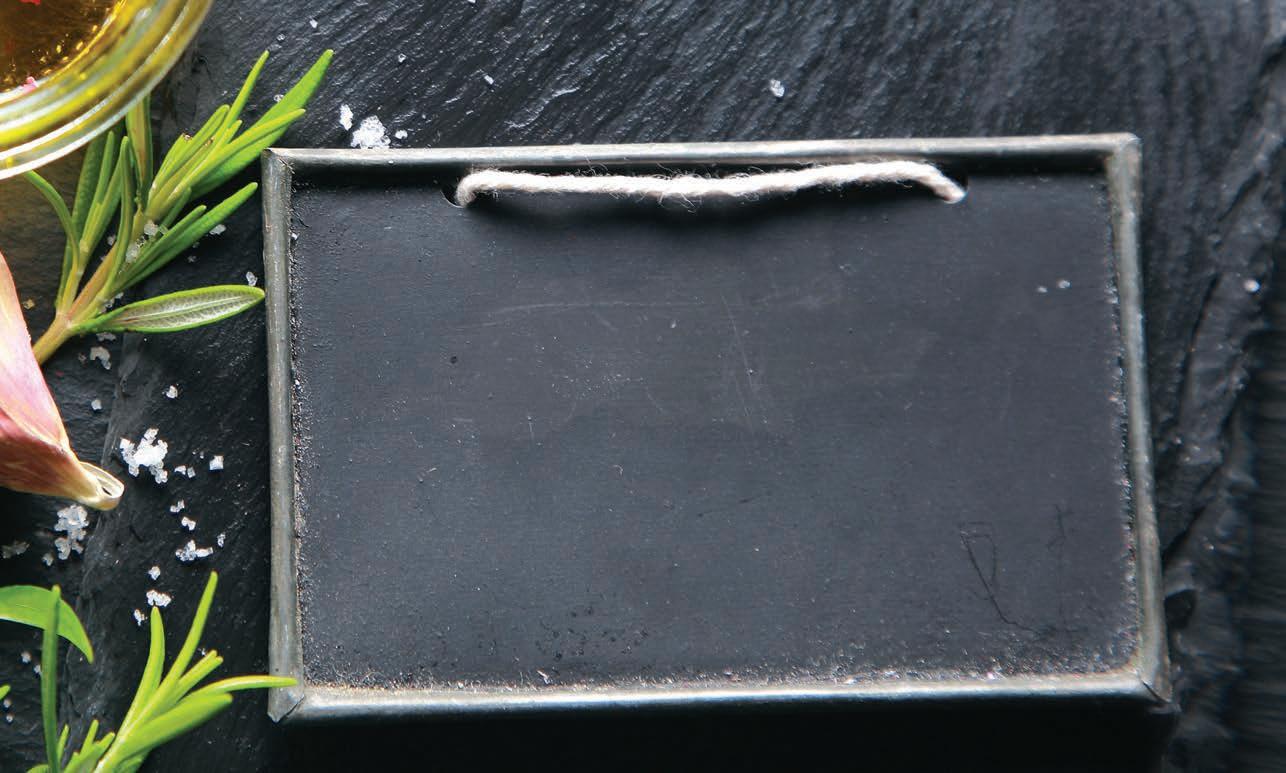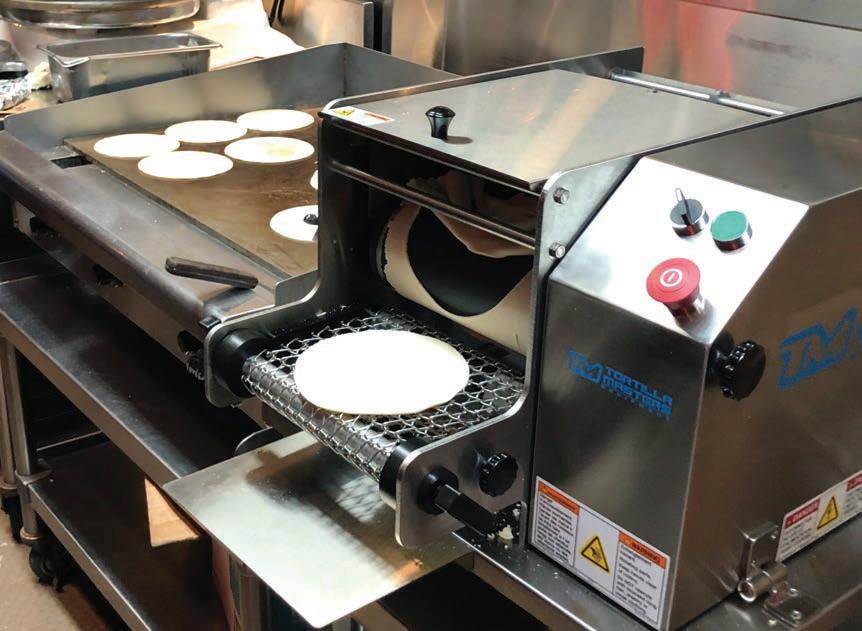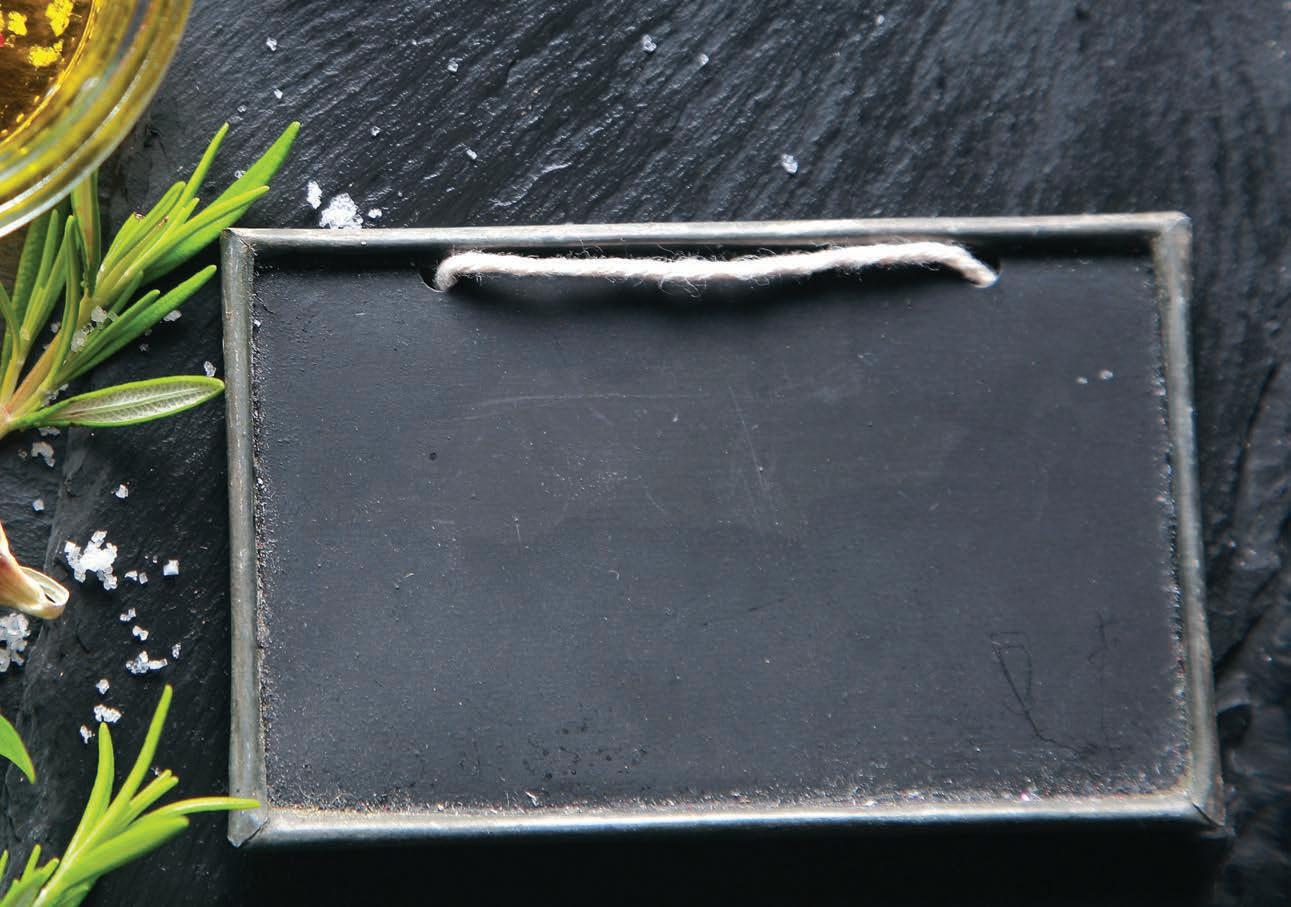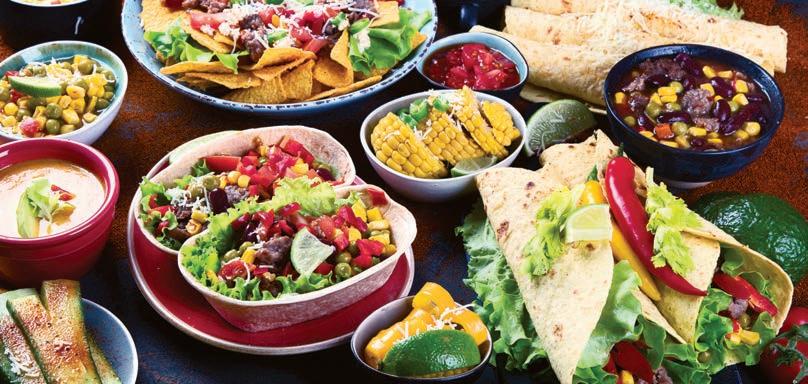
17 minute read
BUSINESS BASICS — Make Your Menu Work for You
Your Menu is a Blank Slate– MAKE IT WORK FOR YOU
EDITOR’S NOTE: COVID has changed most everything for restaurants and their customers. The format and content of menus, for example, have been altered. As a December 2021 SmartBrief story about 2022 trends reports, “Supply chain challenges brought on by the pandemic are forcing many chefs and restaurant operators to change menus on the fly and get creative with whatever ingredients they are able to get. The new year will likely bring sweeping changes to menus to accommodate rising food costs and focus on local ingredients that are more reliably available.” Both Technomic and the National Restaurant Association also cite streamlined menus as a top 2022 industry trend.
To find out more about how restaurants can optimize menus this year, we turned to Izzy Kharasch, president of Hospitality Works, Inc., a Chicago area restaurant and bar consulting firm. Here he shares some tips with el Restaurante readers.
| BY IZZY KHARASCH | Your menu is the single most effective marketing piece your restaurant has to offer. A menu that is done well can increase the check average by more than 20 percent! This means that you can develop a great menu and increase your current sales by 20 percent without having to bring in one more guest.
I am always amazed at restaurants that have an 8½ x11 sheet of white paper, filled with spelling and grammar errors, that they call a menu. The same owners are then surprised when only a few items sell, and the overall check average is far below expectations. Low check averages mean more turnover of staff, and in today’s world that is a real problem.
WHO ARE YOU?
Restaurants in the planning stages, and even those that have been open for years, have a common problem: They lose their focus on who they are. Each owner is trying to please everyone and, by doing so, is creating a menu that is too large with too many items and not enough focus on the concept.
In a recent consultation with a Mexican restaurant owner, we developed a menu based on the demographics of a medium-sized midwestern city. This meant that we considered the demographics of the potential customers in the area, their income, age, family size, etc. We created a very focused and well-rounded menu. In the appetizer section we cut down the offerings from twelve to eight. We kept the top eight sellers and then did some new plating to give the items a new look. Under soup/salad there was only one soup and one salad. To give the menu a more healthy-option spin we added 4 salads and another soup. Once the menu was complete the owner came back and wanted
In the COVID world, our goal has been to remove about 20 percent of the menu items, while keeping the best-sellers so that guests are purchasing those items that do well and those that are most profitable. This also makes the kitchen team more productive. They are not wasting time preparing items that guests are telling us they don’t enjoy by not purchasing those items.
to keep everything that we had — but he wanted to add a full taco section, pasta section and a vegan section, too. This would add about 15 new products to the menu while at the same time watering down the concept. We did not add the items that the owner wanted to because it was too far outside the concept. However, we did add two to three items that were in line with concept. For example, since we were increasing the salad section, the owner wanted a salad that had more of a Mexican flare with zesty chicken or beef, avocado and a spicy dressing, so we did add that.
COVID-ERA CONSIDERATIONS
Pre-COVID, the focus of menu development was to be innovative and exceptional in product and provide exceptional service to the guests who came in to dine. Before the pandemic, sales of pickup/carryout/delivery were about 2 to 4 percent of gross. Since COVID, those services can represent as much as 30 percent of gross sales.
This means restaurants must look at menu creation much differently. They absolutely want to concentrate on the great inside service they will have. However, their menu needs to be nimble enough to serve the external client quickly, have great product for them to take home — and do it all with exceptional service.
My recommendation to my clients has been, “Create the menu for the indoor diner first, then scale it back for pickup/carryout/delivery.” This means that the restaurateur understands that not every menu item travels well, and that the restaurant will only serve its best products in the appropriate places. With the Mexican restaurant client, for the delivery menu we kept all of the appetizers, all of the fajitas, removed all of the salads, and kept the top three seafood sellers
The Magic Bullet?
Unfortunately, there isn’t one! There are, however, just a few simple steps you can take to increase your sales through a well-written and well-developed menu. • Print the menu on quality paper. The servers will be proud to hand it to the guest. Remember, this is your single best marketing piece. • Do what you do best. Don’t try to be everything to everyone. • Create a menu for the COVID world. It has to work for the guests inside and those who will be enjoying the menu off-premises. • Review the descending sales report. Evaluate the data and keep only the items that sell.
• Design the menu so the guest knows your signature items. Boxing or shading these dishes are two ways that can help call attention to items you’re known for and most want to sell.
• Train the staff. The menu does not sell itself. Make sure your team understands the menu and how to promote and upsell.
REFINING YOUR MENU
If your restaurant has been open for a year or more, it’s time to improve the menu and make it more effective in terms of sales and guest satisfaction.
When I work with clients, we start by pulling a descending sales report for the past six months so we know which items have been selling well. Before I review that report, I often ask owners and managers to pick what they believe to be the top 10 items. Most often they may get about half correct — but the reason for this exercise is to make sure everyone understands that decisions must be made based on the reality of the numbers and not just what we think.
In the COVID world, our goal has been to remove about 20 percent of the menu items, while keeping the bestsellers so that guests are purchasing those items that do well and those that are most profitable. This also makes the kitchen team more productive. They are not wasting time preparing items that guests are telling us they don’t enjoy by not purchasing those items.
GUIDE YOUR CUSTOMERS
As I mentioned, a well-written and well-designed menu can improve your restaurant’s sales by 20 percent or more. I am finding that guests want to enjoy a “taste” of a number of items when they go out to eat. It is why I usually put six to eight appetizers on a menu and make
sure they are sharable.
My philosophy is this: I would rather sell one appetizer to share vs. no appetizers. I also suggest highlighting, with a box or some shading, one specialty item you want to sell because it’s a signature item and it’s profitable.
Similarly, I would highlight one soup as well as one entrée, basically to entice the guest. Typically these items sell well not just because we highlighted them but because guests are more likely to ask the server questions about them, creating the all-important guest/server interaction.
RESTAURANTS DON’T LIVE BY MENUS ALONE
I am finding that operations that use QR codes have lower check averages than operations that use actual menus in combination with servers. When guests look at the menu on their phone, they are not learning about the items, whether it be food or beverage. They don’t have the ability to ask questions so they order what they know, not what they might want to try.
For your menu to be effective, you must train, train, train your staff. Every server, busser and host should have tried most items on the menu. They also need to be trained on each item in each dish.
The way to guarantee that you have done this well is to create a menu test. The server who is confident in their menu knowledge is the server with the highest check average.
A year ago, we had a restaurant with a check average of $18 per guest. We did a full staff menu training with menu testing. A pre-shift meeting was held every day to focus on our menu goals for the day. Today that same restaurant is running a check average of $23 per guest. Guests are spending $5 more per person because we have implemented everything I’ve mentioned, including training. This 27 per cent increase in sales for this operation equals $156,000 in sales from the current guests.
The bottom line: Menu design, development and optimization works. Put the work into doing it right and it will pay you back many times over.
Izzy Kharasch is the president of Hospitality Works, Inc. You can reach him at 224-688-3512; Izzy@hospitalityworks.com.






Su menú es un pizarrón en blanco: HAGA QUE LE FUNCIONE

NOTA DEL EDITOR: La covid ha cambiado casi todo para los restaurantes y sus clientes. El formato y el contenido de los menús, por ejemplo, se han visto alterados. Como informa un artículo de SmartBrief de diciembre de 2021 sobre las tendencias de 2022, “los retos de la cadena de suministro provocados por la pandemia están obligando a muchos chefs y operadores de restaurantes a cambiar los menús al instante y a ser creativos con los ingredientes que puedan conseguir. Es probable que el nuevo año traiga consigo cambios radicales en los menús para adaptarse al aumento de los costos de los alimentos y centrarse en los ingredientes locales que están disponibles de forma más confiable”. Tanto Technomic como la Asociación Nacional de Restaurantes también citan los menús optimizados como una de las principales tendencias del sector en 2022. Para saber más sobre cómo pueden los restaurantes optimizar los menús este año, hemos recurrido a Izzy Kharasch, presidente de Hospitality Works, Inc, una empresa de consultoría de restaurantes y bares del área de Chicago. Aquí comparte algunos consejos con los lectores de el Restaurante.
| POR IZZY KHARASCH | Su menú es el elemento de marketing más eficaz que puede ofrecer su restaurante. Un menú bien hecho puede aumentar el promedio de la cuenta en más de un 20 por ciento. Esto significa que puede elaborar un gran menú y aumentar sus ventas actuales en un 20 por ciento sin tener que traer un solo comensal más.
Siempre me sorprenden los restaurantes que tienen una hoja blanca de 8½ x 11, llena de errores ortográficos y gramaticales, a la que llaman menú. Los mismos propietarios se sorprenden luego cuando solo se venden unos pocos platos y el promedio general de la cuenta está muy por debajo de las expectativas. Un promedio de cuenta reducido implica una mayor rotación del personal, y en el mundo actual eso es un verdadero problema.
¿La solución mágica?
Desgraciadamente, ¡no hay ninguna! Sin embargo, hay algunos pasos sencillos que puede dar para aumentar sus ventas a través de un menú bien redactado y desarrollado.
• Imprima el menú en papel de calidad. Los meseros se sentirán orgullosos de entregárselo al cliente.
Recuerde que es su mejor herramienta de marketing.
• Haga lo que mejor sabe hacer. No intente hacerlo todo para todos.
• Cree un menú para el mundo de la COVID. Tiene que funcionar para los clientes dentro del establecimiento y para los que van a disfrutar del menú fuera del mismo.
• Revise el informe de ventas descendente. Evalúe los datos y conserve solo los artículos que se venden.
• Diseñe el menú para que el invitado conozca sus
artículos de autor. Poner en un recuadro o sombrear estos platos son dos formas que pueden ayudar a llamar la atención sobre los artículos por los que es conocido y que más quiere vender.
• Forme al personal. El menú no se vende solo.
Asegúrese de que su equipo entiende el menú y cómo promocionar y vender más.
¿QUIÉN ES USTED?
Los restaurantes en fase de planificación, e incluso los que han estado abiertos durante años, tienen un problema común: dejan de centrarse en lo que son. Cada propietario intenta complacer a todo el mundo y, al hacerlo, crea un menú demasiado amplio con demasiados artículos y sin centrarse lo suficiente en el concepto.
En una consulta reciente con el propietario de un restaurante mexicano, desarrollamos un menú basado en la demografía mediana del Medio Oeste de los Estados Unidos. Esto significaba que tuvimos en cuenta la demografía de los clientes potenciales de la zona, sus ingresos, su edad, el tamaño de la familia, etc. Creamos un menú muy centrado y completo. En la sección de aperitivos redujimos la oferta de doce a ocho. Mantuvimos los ocho más vendidos y luego hicimos un nuevo emplatado para dar un nuevo aspecto a los artículos. En la sección de sopa/ensalada solo había una sopa y una ensalada. Para dar al menú un giro más saludable, añadimos cuatro ensaladas y otra sopa.
Una vez completado el menú, el propietario volvió y quiso mantener todo lo que teníamos, pero quería añadir una sección completa de tacos, otra de pasta y una sección vegana. Esto añadiría unos 15 productos nuevos al menú y al mismo tiempo diluiría el concepto. No añadimos los artículos que el propietario quería porque estaban demasiado lejos del concepto. Sin embargo, sí añadimos dos o tres artículos que se ajustaban al mismo. Por ejemplo, como estábamos aumentando la sección de ensaladas, el propietario quería una ensalada que tuviera un toque más mexicano, con pollo o ternera picante, aguacate y un condimento picante, así que la añadimos.
CONSIDERACIONES EN LA ERA DE LA COVID
Antes de la pandemia, el objetivo del desarrollo del menú era ser innovador y excepcional en el producto y proporcionar un servicio excepcional a los clientes que venían a cenar. Antes de la pandemia, las ventas de los servicios de recogida/ transporte/entrega suponían entre el 2 y el 4 por ciento de las ventas brutas. Desde la COVID, esos servicios pueden representar hasta el 30 por ciento de las ventas brutas.
Esto significa que los restaurantes deben abordar la creación de menús de forma muy diferente. Deben concentrarse plenamente en el gran servicio interior que van a tener. Sin embargo, su menú debe ser lo suficientemente ágil como para atender al cliente externo con rapidez, tener un excelente producto para que se lo lleven a casa, y hacerlo todo con un servicio excepcional.
Mi recomendación a mis clientes ha sido: “Cree primero el menú para quien come en el interior y luego redúzcalo para la recogida/transporte/entrega”. Esto significa que el restaurador entiende que no todos los artículos del menú se conservan bien durante el desplazamiento, y que el restaurante solo servirá sus mejores productos en los lugares apropiados.
Con el cliente del restaurante mexicano, para el menú de entrega mantuvimos todas las botanas, todas las fajitas, eliminamos todas las ensaladas y mantuvimos los tres mariscos más vendidos.
PERFECCIONAR SU MENÚ
Si su restaurante ha estado abierto durante un año o más, es el momento de mejorar el menú y hacerlo más eficaz en lo que respecta a las ventas y la satisfacción de los clientes.
Cuando trabajo con los clientes, empezamos por elaborar un informe de ventas descendente de los últimos seis meses para saber qué artículos se han vendido bien. Antes de revisar ese informe, a menudo pido a los propietarios y gerentes que elijan los que creen que son los diez artículos más importantes. La mayoría de las veces aciertan más o menos la mitad, pero la razón de este ejercicio es asegurarse de que todo el mundo entiende que las decisiones deben tomarse basándose en la realidad de los números y no solo en lo que pensamos.
En el mundo de la COVID, nuestro objetivo ha sido eliminar alrededor del 20% de los artículos del menú, manteniendo los más vendidos para que los clientes compren los artículos que les funcionan bien y los que son más rentables. Esto también hace que el equipo de cocina sea más productivo. No pierden el tiempo preparando artículos que los clientes nos dicen que no les gustan al no comprarlos.
GUÍE A SUS CLIENTES
Como he mencionado, un menú bien escrito y diseñado puede mejorar las ventas de su restaurante en un 20% o más. Me he dado cuenta de que los clientes quieren disfrutar de una “degustación” de varios artículos cuando salen a comer. Por eso habitualmente pongo de seis a ocho botanas en un menú y me aseguro de que se puedan compartir.
Mi filosofía es la siguiente: prefiero vender un aperitivo para compartir que ninguna botana. También sugiero destacar, con un recuadro o algún sombreado, un artículo de especialidad que quiera vender porque es un artículo de autor y es rentable.
Del mismo modo, destacaría una sopa y un plato principal, básicamente para atraer al comensal. Normalmente, estos artículos se venden bien no sólo porque los hayamos resaltado, sino porque es más probable que los comensales hagan preguntas al mesero sobre ellos, lo que crea la importantísima interacción entre el cliente y el mesero.

En el mundo de la COVID, nuestro objetivo ha sido eliminar alrededor del 20% de los artículos del menú, manteniendo los más vendidos para que los clientes compren los artículos que les van bien y los que son más rentables. Esto también hace que el equipo de cocina sea más productivo. No pierden el tiempo preparando artículos que los clientes nos dicen que no les gustan al no comprarlos.
LOS RESTAURANTES NO VIVEN SOLO DE LOS MENÚS
Estoy descubriendo que las operaciones que utilizan códigos QR tienen promedios de cuentas más bajos que las operaciones que utilizan menús reales con la ayuda de los meseros. Cuando los clientes miran el menú en su teléfono, no llegan a conocer los artículos, ni la comida ni la bebida. No tienen la posibilidad de hacer preguntas, así que piden lo que conocen, no lo que podrían querer probar.
Para que su menú sea eficaz, debe formar, formar y formar a su personal. Todos los meseros, ayudantes de meseros y asistentes deben haber probado la mayoría de los artículos del menú. También deben recibir formación sobre cada elemento de cada plato.
La forma de garantizar que ha hecho esto bien es crear una prueba de menú. El mesero que confía en sus conocimientos sobre el menú es el que tiene el promedio de cuenta más alto.
Hace un año, teníamos un restaurante con una media de cuentas de $18 por cliente. Hicimos una formación completa del personal sobre el menú con una prueba de menú. Todos los días se celebraba una reunión antes del turno para centrarse en los objetivos del menú del día. Hoy en día, ese mismo restaurante tiene un promedio de cuenta de $23 por cliente. Los clientes están gastando $5 más por persona porque hemos implementado todo lo que he mencionado, incluida la formación. Este aumento del 27% en las ventas de esta operación equivale a $156,000 en ventas de los clientes actuales.
El resultado final: el diseño, el desarrollo y la optimización del menú funcionan. Dedique esfuerzo a hacerlo bien y le compensará ampliamente.
Izzy Kharasch es presidente de Hospitality Works, Inc. Póngase en contacto con ellos en el 224-688-3512; Izzy@hospitalityworks.com.










